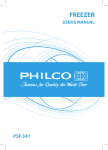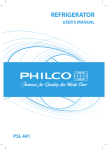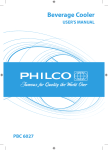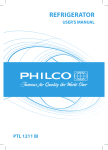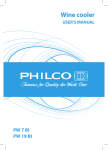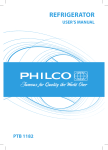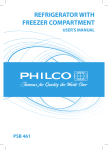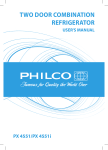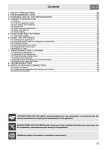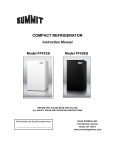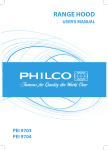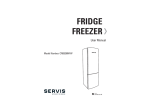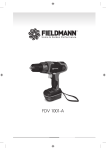Download Manual - FAST.Eu
Transcript
UPRIGHT FREEZER USER'S MANUAL PF 1472 Dear customer, Thank you for buying a PHILCO brand product. So that your appliance serves you well, please read all the instructions in this user's manual. CONTENTS PART 1: BEFORE PUTTING INTO OPERATION ................................................................................................. 2 • Safety notices ...................................................................................................................................................................................2 • Safety instructions for gas R600a ..............................................................................................................................................4 PART 2: DESCRIPTION OF THE PRODUCT ....................................................................................................... 5 PART 3: INSTALLATION .................................................................................................................................... 6 • Transport and unpacking ............................................................................................................................................................6 • Placement ..........................................................................................................................................................................................7 • Cleaning before use .......................................................................................................................................................................8 • Electrical connection .....................................................................................................................................................................8 • Procedure for switching the door opening direction ........................................................................................................9 PART 4: SETTING THE TEMPERATURE ........................................................................................................... 10 PART 5: ARRANGEMENT OF FOOD ............................................................................................................... 11 • Storage of frozen food ............................................................................................................................................................... 11 • Chart on storing food in the refrigerator ............................................................................................................................ 12 PART 6: DEFROSTING .................................................................................................................................... 13 PART 7: REGULAR MAINTENANCE ................................................................................................................ 14 • Cleaning the freezer.................................................................................................................................................................... 14 PART 8: WHAT SHOULD I DO WHEN... ........................................................................................................... 16 PART 9: PERFORMANCE LABEL/INFORMATION SHEET ............................................................................... 17 EN - 1 Copyright © 2013, Fast ČR, a. s. 02/2013 PART 1: BEFORE PUTTING INTO OPERATION Safety notice Symbols: General advice for the optimal operation of the appliance General dangers Hot surfaces Before you put the appliance into operation • Carefully study the user's manual and installation instructions before installing and using the appliance! This user's manual includes important information regarding the installation, operation and maintenance of the appliance. Store the user's manual also for future reference, or for other owners of the appliance if the appliance is sold. If the appliance is transported in a horizontal position the oil from the compressor may leak into the cooling circuit. For this reason, allow the appliance to rest in a vertical position for 12 hours before turning it on, so that the oil flows back into the compressor. After unpacking the appliance, carefully inspect that it has in not been damaged in any way. Also check that the power cord is not damaged. If you discover any defects, turn off the appliance and contact the vendor or in the case of a damaged power cord contact the service centre. If the appliance and all its parts are in order, install it according to the instructions in the relevant chapter. • • • When installing the appliance in its place, or when moving the appliance, the power cord could be penetrated or damaged. Check that the power cord is not interfering anywhere. Before connecting the appliance to the electricity power source check that the capacity of the system corresponds to the specifications on the appliance's rating label. Any kinds of home electric wiring necessary for the connection of the appliance must only be carried out by a qualified electrician. If you move the appliance from its usual position, it is necessary to understand, that although you have disconnected the power cord, the components on the rear side of the appliance may remain very hot for some time. This appliance is not designed to be built-in. Do not cover or block the air inflow or outflow openings. Insufficient ventilation will cause bad operation and damage to the appliance. Operating the appliance • Use the appliance only for the purposes for which it has been designed. • This appliance is designed only for household use, for storing or freezing food and for preparing ice. • The temperature inside the freezer may rise or fall slightly, and so these appliances are not suitable for storing products (e.g. medicines), which require a stable temperature. Do not use any other electric appliances (e.g. heating elements, electric ice cream machines, etc.) inside the appliance. There is a danger of explosion! EN - 2 Copyright © 2013, Fast ČR, a. s. 02/2013 Do not place food inside the freezer containing flammable propulsion gases (e.g. sprays) and no explosive, contaminating or volatile substances. There is a danger of explosion! Do not store liquids inside bottles and cans (especially beverages containing carbon dioxide) inside the freezer compartment. The bottles and cans could crack! • • • • Store liquor only with a firmly tightened cap and in a vertical position. Do not use the base, drawers, the door of the appliance, etc. as a step or as a support. There is a danger of injury to persons or damage to the appliance. Ensure that the plastic parts of the appliance and the door seals are not soiled with oil or grease. The plastic parts and the seals would then become porous. Do not consume frozen food immediately after taking it out of the freezer compartment. There is a danger of frost bite! Avoid prolonged hand contact with frozen food, ice or evaporating pipes. There is a danger of frost bite and freezing to these objects! We do not recommend placing hot liquids or food inside the freezer and filling containers all the way to the rim. Do not put fragile, heavy or unstable objects on the freezer. Children in the household • Never leave packaging and its parts with the children. There is a danger of poisoning or suffocation by the cardboard boxes and plastic sheets! • This appliance is in no way a toy for children! • For appliances with door locks: do not leave keys within the reach of children! • If you will not be using the freezer anymore, remove the door, seals and store it in a safe place. In this way you will prevent the danger of children becoming trapped inside the freezer. Maintenance and cleaning Before you begin with regular or exceptional maintenance, disconnect the appliance's power cord or turn off the fuse or circuit breaker. Never pull the electric power cord, only pull on the power plug. Do not use mechanical or any other devices, except for devices recommended by the manufacturer for the purpose of accelerating the defrosting process. • • Do not defrost or clean the appliance using a steam cleaning device! The steam may come into contact with the electric components inside the appliance, where a short circuit could occur. There is a danger of electric shock! Do not remove the frozen ice layer and frozen on food using a knife or a sharp object. This could damage the cooling medium pipes. The escape of the cooling medium may cause eye injuries or may catch on fire. General instructions • This appliance must not be used by persons (including children) with physical, sensory or psychological impairments or by inexperienced persons, unless properly trained or schooled in the safe use of the appliance, or unless they have been properly supervised by a person who will be responsible for their safety. Children should be supervised so as not to play with the appliance. • This appliance has been tested in accordance with the directives in force in the European Union. • The tightness of the cooling circuit has been verified. • This appliance conforms to the relevant safety provisions for electrical appliances in force in the European Union. EN - 3 Copyright © 2013, Fast ČR, a. s. 02/2013 Technical safety The appliance contains a cooling gas, ISOBUTHAN (R600a). Only transport or move the appliance with the utmost care, prevent excessive impacts and shaking to prevent damaging the appliance. If the cooling circuit becomes damaged and the cooling gas may be escaping, there is a risk of an explosion, which may be ignited by a spark or flame. If the appliance shows signs of damage, it must not be put into operation. In such a case contact the service centre, ventilate the room where the appliance is located and prevent the spreading of flames or other interference with the appliance. Safety instructions for gas R600a Measures in case of an unexpected release If ventilation is possible, allow the material to evaporate. Characteristics of the gas The gas is highly flammable, it is necessary to completely prevent contact with an open flame and hot surfaces. Because the R600a gas is heavier than air, it may become very concentrated at the level of the ground, where ventilation is weak. First aid Inhalation Take the affected person from the contaminated area to a warm, well ventilated location. Staying in a contaminated location for a long time may cause suffocation, or potentially loss of consciousness. If necessary, provide mouth-to-mouth resuscitation and in exceptionally serious situations, under expert medical supervision, give oxygen. Contact with the skin Random contact with the skin will not endanger health, it is better to thoroughly wash the affected area. The liquid spray or dispersed liquid may cause frost bite, wash the affected area with large amounts of water and contact a medical doctor. Contact with the eyes If eyes have been affected, wash out with large amounts of water, while trying to keep the eyes open, and call a specialised doctor as soon as possible. If contact or inhalation of the R600a gas occurs, contact your medical doctor. EN - 4 Copyright © 2013, Fast ČR, a. s. 02/2013 PART 2: DESCRIPTION OF DEVICE 8. 7. 1. 6. 2. 5. 3. 4. 1. 2. 3. 4. 5. 6. 7. 8. Cabinet Drawers Compressor (in the rear part of the appliance) Levelling feet Door Door seals Temperature dial Top plate Thermostat EN - 5 Copyright © 2013, Fast ČR, a. s. 02/2013 PART 3: INSTALLATION Transport and unpacking If the appliance is transported in a horizontal position the oil from the compressor may leak into the cooling circuit. For this reason, allow the appliance to rest in a vertical position for 12 hours before turning it on, so that the oil flows back into the compressor. Remove the external packaging, remove the protective plastic film from the surface of the appliance (if used) and clean the external parts of the appliance with an agent designed for this purpose. Do not use steel wool or any coarse agents, which could irreparably damage the surface of the appliance. Carefully remove all papers and adhesive tape from the appliance, the door and other parts packed in polystyrene. Remove documents and accessories from inside the appliance. The packaging material is recyclable and is marked with a recycling symbol. For disposal follow the local regulations. Packaging materials (plastic bags, polystyrene parts, etc.) must be kept out of the reach of children, because they present a possible source of danger. Carefully inspect the appliance. If you discover any defects, stop the installation and contact the vendor. Operating conditions The proper operation of the appliance, the freezing temperatures are guaranteed only when the following conditions are met: The temperature in the room where the appliance is located conforms to the climate class stated on the appliance's rating label. Maximum ambient relative humidity: 90%. The appliance must be placed at a sufficient distance from heat sources (e.g. baking ovens, central heating, direct sunlight, etc.). The appliance must be located in such a place that it is protected against the effects of weather. Regular maintenance is performed according to the instructions in this user's manual. The ventilation openings in the cover of the appliance must not be covered by anything. Correct installation (e.g. levelling, the capacity of the system correspond to the specifications on the rating label of the appliance). Table – Climatic class Climatic class Ambient temperature SN +10°C to +32°C N +16°C to +32°C ST +16°C to +38°C T +16°C to +43°C EN - 6 Copyright © 2013, Fast ČR, a. s. 02/2013 Location The location for the placement of the appliance must meet the requirements in the paragraph "Operating conditions" and must have a stable floor with a load bearing capacity corresponding to the weight of the appliance. Furthermore you must maintain distances and dimensions of the appliance, so that correct operation is ensured: 1. Top part at least 20 cm; 2. Rear part at least 10 cm; 3. The wall on the side where the door opens at least 30 cm. Level the appliance using the adjustable feet, ensure there is a gap between the bottom edge of the appliance and the ground, so that there is sufficient circulation of the cooling air, by which you will ensure the optimal performance of the cooling circuit. Check whether any cooling circulation pipes have been damaged during the installation. Use the appliance only for the purposes for which it has been designed. The appliance must be located on a rigid and even surface. In this way you will ensure free circulation of the coolant and effective operation of your appliance. If possible, place the appliance into a cool, well ventilated and dry room. Do not locate the appliance in direct sunlight, or in a room with a high temperature, in the vicinity of any sources of direct heat, such as heating, an oven, a stove, etc. – this would mean that the compressor would need to work a lot harder resulting a substantially higher power consumption level. If it is not possible to prevent the installation in the vicinity of a heat source, we recommend the insertion of an appropriate insulating board (do not use asbestos) between the appliance and the heat source; or at least to maintain the following minimum distances: From a gas or electric stove 3 cm; From a heater or oven, etc. 30 cm; From another cooling appliance 2 cm. Do not place any appliances on the appliance, which release heat on to the appliance, such as microwave ovens, toasters, etc. Never cover the ventilation grill. Pull out the power plug by pulling on the plug itself, never pull on the cord when disconnecting the appliance. Before turning on the appliance allow it to stand in its final location for 12 hours, the coolant circuit will stabilise in this way and no operating problems will occur. Before connecting the appliance to the power grid check that it is perfectly dry inside – especially in the corners. Danger warning The coolant may be highly flammable, depending on its composition. The coolant circuit was hermetically closed and sealed and was tested many times for possible leaks. Any unqualified tampering with the product may cause a fire hazard. Check that there is no mechanical interruption or effect on the coolant circulation, namely in the accessible parts around the compressor. Only professionally qualified persons may work on the cooling system. EN - 7 Copyright © 2013, Fast ČR, a. s. 02/2013 Cleaning before use Check that you have removed from the appliance all adhesive tape used to hold accessories . Then clean all the inside parts using lukewarm water with a neutral cleaning agent, vinegar or sodium carbonate – in this way you will remove the characteristic odour of new parts – then dry carefully. Do not use detergents or aggressive agents, which could damage the surfaces. Electrical connection Before connecting the power plug to the power socket, check that: Your hands are completely dry. The voltage and frequency shown on the performance label of the appliance corresponds to that in the home power grid (permitted tolerance from -6% to +6% for nominal voltage, for use with different voltages, use a voltage changer with the corresponding parameters). The cord and the plug are not damaged or caught under heavy objects. The power cord is not excessively tensioned, it is not permitted to use an extension cord. Do not connect the appliance to a voltage rectifier (e.g. solar power plant) or use an extension cord. The appliance must be connected to a working grounding lead. If the power socket of the home system is not grounded in accordance with the current legal regulations, connect the appliance after consulting a specialised technician to the grounding lead itself. The manufacturer takes no responsibility for injuries caused as a result of not following these instructions. If you do not correctly level the freezer during the installation, the door may not close shut and seal properly, which may cause problems with the cooling, ice build up or moisture. Levelling the freezer is very important. Level the freezer using the adjustable feet – turn them clockwise to lift the freezer and turn them anticlockwise to lower the freezer. EN - 8 Copyright © 2013, Fast ČR, a. s. 02/2013 Procedure for switching the door opening direction The direction to which the door opens can be changed from the right (as supplied) to the left, if this is necessary at the installation location. WARNING! The appliance must be disconnected from the power grid when changing the door opening direction. Pull the power plug out of the power socket before installation. Tilt the appliance backwards and lean it safely in position. Unscrew the hinge bolts and take out the pin of the holder. Open the door a little and slide it out by pulling it downwards. Unscrew the top pin and screw it in on the opposite side. Attach the door into the top pin and close it. Using bolts to screw in the pin of the holder on the other side of the appliance. EN - 9 Copyright © 2013, Fast ČR, a. s. 02/2013 PART 4: SETTING THE TEMPERATURE Set the temperature in the freezer using the temperature control knob. The thermostat control module is connected to the compressor. The thermostat is located inside the control panel. It regulates the temperature in the freezer. Position «Min» – cold Position «Normal» – normal freezing Position «Max» – maximum freezing The temperature inside the freezer will be affected by: the room temperature; the number of times (how frequently) the door is opened; the amount of stored food; installation location of the appliance. When setting the correct temperature it is necessary to consider all the above factors. Initially it is essential to experiment to gain practical experience with the settings. EN - 10 Copyright © 2013, Fast ČR, a. s. 02/2013 PART 5: ARRANGEMENT OF FOOD Appropriate wrapping materials for food are plastic containers, aluminium foil, polyethylene freezing bags, etc. Always allow hot dishes to cool down before placing them into the freezer. Open the door only for a short time so that the inside area of the freezer is not heated. This saves energy. Never store explosive materials or products with flammable compressed gasses (e.g. whipped cream sprayers with pressurised capsules/cartridges, spray cans) – DANGER OF EXPLOSION! Storage of frozen food If you have turned on the freezer for the first time or you have just defrosted it, turn the thermostat controller to the value "Max" or "Super" for at least 2 hours before putting food into the the freezer. All frozen food must be put into the freezer as soon as possible after being bought, so that they do not defrost and cause potential contamination. Store frozen products according to the manufacturer's instructions on the packaging. Pay increased attention to handling the drawer, so that you do not damage the cooling circuit. symbol means that frozen food will be stored in the freezer at a temperature of -18 C or lower, This which makes long term frozen food storage and freezing of fresh food possible. The temperature of the freezer is automatically controlled by the thermostat. NOTE: The maximum amount of food that can be frozen in 24 hours is 4kg. Placing fresh food into a freezer Ensure that the freezer is clean as the freezing process itself does not sterilise food. We recommend freezing food in the original packaging, or in various containers suitable for freezing or in special freezer bags. Never place hot or warm dishes into the freezer. Allow dishes to fully cool down before placing them into the freezer, wrap them in a plastic bag, aluminium foil or put them in a jar. Check the label on the freezer, to check how many kilos of fresh food (at a room temperature of 25°C) the freezer is able to freeze in 24 hours. Never insert more food than the permitted amount. Never place bottles with fizzy drinks into the freezer nor any other bottles. For better freezing results give the food sufficient room for air circulation. We recommend a setting between the medium and maximum value for standard use and for long term food storage in the freezer. ATTENTION! Do not store cans and bottles with beverages containing carbon dioxide in the freezer. The contents expand during the freezing process, which may rip the bottle or can apart. Risk of injury and damage! Consume ice cream only several minutes after removing it from the freezer – you will avoid injury to your lips and tongue. Do not touch the inside of the freezer if you have wet hands. EN - 11 Copyright © 2013, Fast ČR, a. s. 02/2013 Important information Place only properly wrapped food into the freezer. When storing deep frozen food intended for immediate consumption, note the expiry date marked by the manufacturer. Remember that only quality fresh food is suitable for freezing. Freeze fresh food in appropriately sized portions. Ensure that you use an appropriate wrapping material (plastic wrap, aluminium foil, freezing bays). Push all air out of the packages. To close the packages use rubber bands, plastic clips, tie wire or adhesive tape resistant to cold. Plastic bags and tubes can also be closed using a food sealing appliance. On the closed package write down the contents, weight and date of freezing. Before placing plastic bags into the freezer check that they are dry so as to prevent them from freezing to each other. To prevent partial defrosting, place the food that is to be frozen in such a way that it is not touching the already frozen food. Do not refreeze fully or partially defrosted food apart from the case where they were heat processed (cooked or fried/baked). Do not consume food that has been stored for a period longer than its expiry date. You may cause yourself food poisoning. Chart on storing food in the freezer Food Storage method Zone Durability Storing frozen food, ice cubes and ice creams Original packaging, well sealed Top part of the freezer Depends on expiry date Frozen food: meat and fish Original packaging, well sealed. Food containers suitable for low temperatures, hermetically sealed. Best in the bottom part of the freezer Beef: 12 months Pork: 12 months Minced pork: 6 months Rabbit: 6 months Veal: 9 months Mutton: 9 months Poultry: 6 months Fish: 6 months Frozen food: pasta dishes, fruit, vegetables, confectionery Food containers suitable for low temperatures, hermetically sealed. Top part of the freezer 6-12 months EN - 12 Copyright © 2013, Fast ČR, a. s. 02/2013 PART 6: DEFROSTING Disconnect the power cord from the power socket. Open the door and take out all the food and place it in a cool place. Using the plastic scraper remove the ice from the walls of the freezer or allow the ice to naturally melt away. Then wipe out the remaining ice and water, wipe dry and connect the power cord to the power socket. NOTE Do not use sharp objects for the removal of frozen food or ice, the wall of the freezer could be scratched. When defrosting the freezer never use electric appliances such as hair fans, hot air fans, steam cleaners, de-icing sprays or open flames (e.g. candles). The plastic interior could melt and the resulting foam gas could be ignited from a spark or an open flame. Never use a steam cleaner to melt a layer of ice in the appliance (high risk of injury by electrical shock). Remove the frozen food and wrap into several newspaper layers. Place the frozen food in a cold place until it is possible to use the freezer again. Leave the freezer door open. Ice deposit layers form in the freezer during the normal course of operation. After exceeding a certain thickness, they function as insulation and interrupt heat transfer. Do not scratch the ice deposit layer because you could damage the evaporation surface. Perform the defrosting process as fast as possible to prevent the removed food from defrosting. Constantly remove water using a sponge. You can speed up the defrosting process by placing a bowl with hot water (not boiling) into the freezer. In this case close the freezer door. As soon as the freezer has been fully defrosted, empty the water accumulated in the bowl into a kitchen sink. Wipe the freezer area until dry and return the food. Connect the appliance to the power socket. EN - 13 Copyright © 2013, Fast ČR, a. s. 02/2013 PART 7: REGULAR MAINTENANCE Cleaning the freezer Before commencing to clean the freezer disconnect it from the power source. Use a clean sponge or a soft cloth and a gentle washing detergent dissolved in warm water. Do not use coarse or abrasive cleaning products. Wash the freezer well and wipe dry. Do not use cleaning waxes, concentrated cleaning agents, bleaches or cleaning products containing kerosene on the plastic or rubber parts. Never use paper towels or window cleaners on the plastic parts. Clean the inside of the appliance at regular intervals. We recommend that the freezer is cleaned every time it is defrosted. Take out all the food and place them in a cool place. Remove all removable parts from the appliance. Various parts inside the freezer are generally not suitable for washing in a dishwasher. These parts should be washed in warm water with dish washing detergent. Never use an undiluted cleaning detergent and under no circumstances use abrasive or acidic, i.e. chemical cleaning agents. We recommend a general purpose detergent with a neutral pH. The use of steam cleaning appliances is extremely dangerous and so is strictly forbidden. Wipe the inside area and the accessories with clean water and dry everything using a dry cloth. Then allow the appliance to ventilate for 3 – 4 minutes. Do not damage or remove the rating label on the rear side of the appliance – it is important for connection, repairs and subsequent disposal of the appliance. Ensure that water does not come into contact with parts inside the appliance that are under live electric current. Ensure that the water from the defrosting process can flow away freely through the drainage channel. From time to time clean out the drainage opening using a cotton bud. Cleaning water should not run through the drainage channel for defrosted water. This causes the evaporation bowl to overflow and cleaning water flows on to the floor. Taking out of operation for an extended period If you are not going to be using the freezer for an extended period of time, do the following: Disconnect the freezer from the power source by pulling it out of the power socket. Clean out the inside and dry it out as described in the part Cleaning the freezer. Leave the door open to prevent an unpleasant odour forming inside. EN - 14 Copyright © 2013, Fast ČR, a. s. 02/2013 Please be aware: Compressor The compressor is controlled by the thermostat, which is set by the temperature dial, and turns itself on automatically when temperatures inside the appliance is exceeded and then turns itself off as soon as it again reaches this temperature. When any compressor – cooling system is turned on – noise can be heard. These sounds are made when the motor in the compressor is working and they are also made by the coolant circulating in the circuit of the cooling system. These noises are normal and do not indicate any malfunction in the operation of the appliance. In unheated rooms or in cold weather conditions condensate may form on the exterior walls of the appliance. This does not indicate a malfunction and this condensate will disappear as soon as the temperature rises. Contact the service department only when, after analysing all possible factors of the malfunction you cannot find any cause for the malfunction or you are unable to remedy the malfunction yourself. So, first focus on: " What should I do when...." EN - 15 Copyright © 2013, Fast ČR, a. s. 02/2013 PART 8: WHAT SHOULD I DO WHEN... Before contacting a professional service centre, please, check the following points: Problem Solution Check whether there is electricity in the power socket. The appliance is not connected to electrical power. Check whether a power outage occurred. Check fuses and circuit breakers. The temperature in the freezing part is too high. Check whether the ambient temperature in which the appliance is operating is between 16ºC and 32ºC. Move the appliance if necessary. Check that the thermostat is correctly set with respect to the surrounding conditions The freezer door cannot be opened. Was the door open? If yes, leave it closed for a few minutes to allow the air pressure to level out. Set the thermostat to the correct temperature. See page 5. Check whether the door is closed. The compressor is running – not switching off. Recently a large amount of food was placed inside the freezer and/of the door was frequently opened. Check that air circulation is not impeded. Check that the door is not open. Excessive amount of frost build-up and ice. Check that there is noting preventing the door from closing. Is the door gasket undamaged and clean? Has defrosting been regularly performed? Noise See normal operating sounds. If problems persist even after the above checks have been performed, contact an authorised service centre. Please be aware that for warranty service it is necessary to present proof of purchase. EN - 16 Copyright © 2013, Fast ČR, a. s. 02/2013 PART 9: RATING LABEL/INFORMATION SHEET The rating label with all the technical specifications is located on the side of the inside wall or on the rear side of the appliance. Information Sheet INFORMATION SHEET: Philco Philco brand: Brand Product number Type of appliance 3) Energy efficiency class (A... low electricity consumption to G high electricity consumption) Electricity consumption per 365 days 1) kWh Total available volume: l of which: refrigerator part l of which: freezer part l Star mark for the freezer area Freezing capacity kg/24h Climatic class 2) Voltage Noise level 4) dB (re 1pW) Dimensions cm (h x w x d) cm Weight kg Philco PF 1472 7 A++ 164 147 147 **** N 220-240 V ~ 50 Hz 42 143x55x56 51 1) Electricity consumption in kWh / year is based on the results of a normalised test carried out over a period of 24 hours. Actual electricity consumption depends on the use and location of the appliance. 2) SN: ambient temperatures from +10 °C to +32 °C ST: ambient temperatures from +18 °C to +38 °C N: ambient temperatures from +16 °C to +32 °C 3) 1 = Refrigerator without low temperature areas 7 = Refrigerator/freezer with low temperature areas *(***) 8 = Box freezer 4) Noise level according to European norm EN 60704 NOTE: All the here mentioned data is subject to change. EN - 17 Copyright © 2013, Fast ČR, a. s. 02/2013 INSTRUCTIONS AND INFORMATION REGARDING THE DISPOSAL OF USED PACKAGING MATERIALS Dispose of packaging material at a public waste disposal site. DISPOSAL OF USED ELECTRICAL AND ELECTRONIC APPLIANCES The meaning of the symbol on the product, its accessory or packaging indicates that this product shall not be treated as household waste. Please, dispose of this product at your applicable collection point for the recycling of electrical & electronic equipment waste. Alternatively in some states of the European Union or other European states you may return your products to your local retailer when buying an equivalent new product. The correct disposal of this product will help save valuable natural resources and help in preventing the potential negative impact on the environment and human health, which could be caused as a result of improper liquidation of waste. Please ask your local authorities or the nearest waste collection centre for further details. The improper disposal of this type of waste may fall subject to national regulations for fines. For business entities in the European Union If you wish to dispose of an electrical or electronic device, request the necessary information from your seller or supplier. Disposal in other countries outside the European Union If you wish to dispose of this product, request the necessary information about the correct disposal method from local government departments or from your seller. This product meets all the basic EU regulation requirements that relate to it. Changes to the text, design and technical specifications may occur without prior notice and we reserve the right to make these changes. EN - 18 Copyright © 2013, Fast ČR, a. s. 02/2013




















